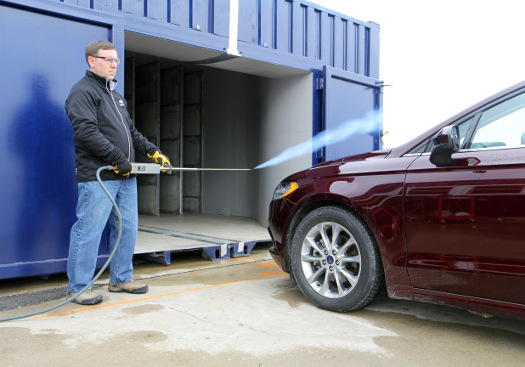 |
| May 17, 2016 | Volume 12 Issue 19 |
Designfax weekly eMagazine
Archives
Partners
Manufacturing Center
Product Spotlight
Modern Applications News
Metalworking Ideas For
Today's Job Shops
Tooling and Production
Strategies for large
metalworking plants
Wheels:
Ford rolls out mobile aeroacoustic wind tunnels

Bill Gulker, Ford wind noise core supervisor, tests a Ford Fusion at the world's first mobile aeroacoustic wind tunnel, here set up at Flat Rock Assembly Plant in Flat Rock, MI.
Consumers want quieter vehicles; it's a leading purchase consideration among those looking for a new car. So Ford has come up with a better way to make its vehicles even quieter.
The world's first fully mobile aeroacoustic wind tunnel is an innovative, patent-pending test system that allows for sources of unwanted wind noise in early production vehicles to be identified faster and solutions developed sooner. In the end, customers drive away in cars designed with a quiet interior that's proving essential to delivering a refined vehicle experience.
"This project was born from a desire to be the best when it comes to controlling and limiting the cabin noise customers are so sensitive to," said Bill Gulker, Ford wind noise core supervisor. "And our new mobile wind tunnel saves our engineers time and increases productivity."
Ford's new wind tunnel made its debut at the Flat Rock Assembly Plant in Michigan, joining a growing fleet of mobile testing facilities, including three environmental evaluation chambers (see Designfax story "Mobile climate and road simulators help knock out squeaks and rattles in all-new Ford F-Series Super Duty" here).
Changing the business of quiet
Full-size aerodynamics labs, such as Ford's main wind tunnel in Allen Park, MI, are outfitted with the latest in sensitive measuring and analysis equipment. These office building-size facilities are specialized for advanced aerodynamic and aeroacoustic development work on future models, with each facility costing about $50 million. Due to the specialized instruments and cost, running time for these facilities and the machines inside them is precious.
Ford's new mobile wind tunnel costs a fraction of what a full-size lab costs. Because testing requires only a steady stream of highway-speed wind, many of the large and sensitive instruments of a full aero lab aren't required. But high-tech, in-cabin sensors like the Aachen head and Noise Vision can still be used.
With an on-site wind noise facility, Ford factories can pull more sample vehicles directly from the line and test them with no delay, which eliminates the time and complexity of shipping vehicles back and forth across the country.
And issues requiring assembly process refinement can be detected and resolved earlier, since everybody involved is on hand.
"Now we're able to detect even the most subtle noises," said Gulker. "We can identify an area in need of improvement, have key people gather, communicate quickly, and resolve the issue without delay."
Reimagining a wind tunnel
The mini wind tunnel environment is similar in concept to a full-scale wind tunnel lab, but the heart of the mobile facility is built inside two 53-ft shipping containers. Each includes aeroacoustic vanes and internal ducting to provide smooth, controlled airflow at the nozzle end of the machine, while two 16-bladed, 6-ft-diameter ducted fans (each powered by a 250-hp electric motor) deliver a maximum blast of 80-mph wind. A series of doors around the containers ensures the sections remain secure during transport or storage.
The machine consists of the two main containers fastened together side by side on flat, level tarmac. In between, two roll-up doors are lifted, while doors on the front and back ends are opened to create the air intake and outlet nozzle. A third, 40-ft container, which houses a small office, power distribution, and controls, is placed nearby, and data and power cabling are connected between the containers.
The entire operation can be broken down within a day, shipped to any Ford North American assembly facility via truck, then reassembled at the new site and be ready for testing within hours.
Agility, and the drive for quality
Ford's ability to perform wind noise testing at the plants means its main wind tunnel in Allen Park is now freed up to concentrate on product development work for future models. The aim is that this setup will lead to more time spent on each new vehicle, shortened development times, and, ultimately, quieter cabins and better fuel economy.
The new mobile wind tunnel directly benefits the company's wind noise engineers, too, both personally and professionally. They can now work more efficiently, because they no longer have to spend so much time away from their families, traveling to and from plants and the main facility.
Fast facts about the new mobile wind tunnel facility include:
- Maximum sustained wind speed: 80 mph;
- Maximum system power: 500 hp;
- Diameter of each ducted fan: 6 ft;
- Facility capability: 24-hr-a-day operation by two workers;
- Enormous power distribution cables weigh 10 lb per ft, each plug weighs 40 lb; in total, each 100-ft cable weighs approximately 1,080 lb; and
- In spite of the machine's huge power, it registers just 75 decibels at a distance of 6 ft from the test area -- roughly equivalent to a telephone dial tone.
Source: Ford Motor Co.
Published May 2016
Rate this article
View our terms of use and privacy policy
